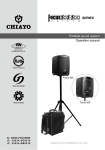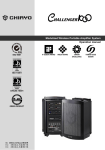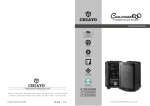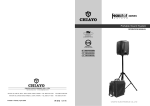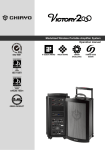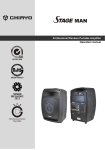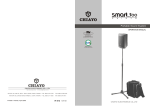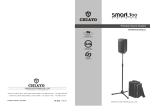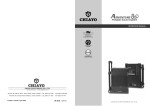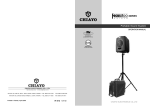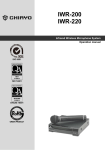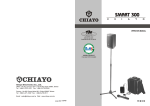Download Wireless Portable Amplifier System Operation manual
Transcript
Wireless Portable Amplifier System Operation manual ISO 9001 R EG ISTER ED IS O 140 01 ISO 14001 R EG ISTER ED FOCUS 505 OHSAS 180 01 OHSAS 18001 GREEN PRODUCT FOCUS 500 TAIWAN EXCELLENCE TAIWAN GOOD DESIGN IC: 3563A-FOCUS505 IC: 3563A-SQ5016 IC: 3563A-SM5016 Please read and follow the instructions in this manual thoroughly to obtain optimum results from this unit. We also recommend that you keep this manual handy for future reference. Safety Precautions Be sure to read the instructions in this section carefully before use. Make sure to observe the instructions in this manual as the conventions of safety symbols and messages regarded as very important precautions are included. Safety symbols and messages described below are used in this manual to prevent bodily injury and property damage which could result from mishandling. Before operating your product, read this manual first and understand the safety symbols and messages so you are thoroughly aware of the potential safety hazards. WARNING Indicates a potentially hazardous situation which, if mishandled, could result in death or serious personal injury. CAUTION Indicates a potentially hazardous situation which, if mishandled, could result in moderate or minor personal injury, and/or property damage. Make sure to observe the following handling precautions so that a fire or personal injury does not result from leakage or explosion of the battery. Do not short, disassemble, heat or put the battery into a fire. Never charge batteries of the type which are not rechargeable. Do not solder a battery directly. Be sure to use the specified type of battery. Note the correct polarity when inserting a battery in the unit. Avoid locations exposed to the direct sunlight, high temperature and high humidity when storing batteries. WARNING To prevent the electromagnetic wave from badly influencing medical equipment, make sure to switch off the unit's power when placing it in close proximity to the medical equipment. CAUTION Battery discharge naturally according to a certain pattern even not in use. For best performance and a prolonged lifespan, battery should be charged regularly after every use or every month when the system is in storage and not being used! CD player optical pick up head is a very delicate device and sensitive to humidity. Please avoid using it in high humidity area to avoid damage! . -1- ISO 9001|ISO 14001|OHSAS 18001 Congratulations and thank you for purchasing this all-in-one compact portable sound system. To ensure a trouble-free operation, please read this manual thoroughly and fully understand its controls and functions. Configuration All versions of Focus series comes equipped with the following: 1. A switch mode power supply. 2. One or two wireless transmitters (except non-wireless versions). Optional accessories 1. Carrying bag 2. Tripod stand 3. Wall bracket 4. UHF/Infrared transmitter charger 5. Focus active speaker / passive speaker 6. Wired microphone Remark Manufacturer reserves the rights to change the above combinations without prior notice. FCC Caution To assure continued compliance, any changes or modifications not expressly approved by the party responsible for compliance could avoid the user’s authority to operate this equipment. (Example - use only shielded interface cables when connecting to computer or peripheral devices. This device complies with Part 15 of the FCC Rules and RSS-123 of Canada. Operation is subject to the following two conditions: (1) This device may not cause harmful interference, and (2) this device must accept any interference received, including interference that may cause undesired operation. -2- Parts and functions on FOCUS control panel 1. Mic volume control 2. Aux volume control 3. Wireless mic 1 4. Wireless mic 2 5. Bass control 6. Treble control 7. Voice priority 8. Mic input 9. Aux input 10. Aux output 11. External speaker 12. WR1 channel selector 13. WR2 channel selector 14. Battery low indicator 15. Charging indicator 16. DC in 17. Fuse 18. Power switch 19. Battery compartment release Focus Active Speaker 1. Aux volume 2. Aux input 3. Battery low indicator 4. Charging indicator 5. DC in 6. Fuse 7. Power switch 8. Battery compartment release FOCUS Passive Speaker 1. Audio input 2. Battery compartment release -3- ISO 9001|ISO 14001|OHSAS 18001 Operating procedures After unpacking the unit for the first time, please charge the unit for about 4~5 hours before any operation. This is absolutely necessary as the built-in rechargeable battery might have been discharged naturally due to long shipment and storage time, even though it has been fully charged in the factory prior to shipment. To charge the battery, just plug in the DC end of the switch mode power supply into the DC IN of the unit and charging will start automatically. The charging indicator LED flashes GREEN during the charging process. When GREEN LED stays glowing, the battery is then fully charged and operation could now be started. To operate this portable sound unit, switch on the main POWER, which will glow GREEN. However, the main POWER switch does NOT switch on the WR module, CD / USB player and Digital Recorder as each of them has a dedicated Power / Volume control switch indicated by WR1, WR2. CD/USB Player and Digital Recorder have individual power switch on its panel. When the Charging / Battery Status Indicator glows RED, it means the built-in rechargeable battery is weak and needs to be charged. While charging, the unit could also be operated simultaneously. Operating the built-in Wireless (WR) receiver modules On the Focus control panel, there are two designated power switch / volume control knobs for the built-in Wireless Receiver (WR). They are indicated by WR1 and WR2. To use the first wireless microphone, switch on the WR1 power cum volume control switch, Red LED next to it will glow. Switch on the corresponding transmitter (RF). Rotate the volume control knob clockwise and amplified sound could be heard if voice is spoken into the transmitter. To use the second wireless microphone, switch on WR2 power cum volume control switch and repeat the same operation as above. Operating the wired microphone. To use a cable microphone, simply plug it into the MIC IN jack. Rotate the dedicated volume control knob and master volume control, amplified sound could be heard from the speaker when voice is spoken into the cable microphone. -4- SDR-5200M IrDA|SDR-5100M receiver modules 1. Channel indicator 2. Diversity A/B indicator 3. Audio signal indicator 4. IR sensor area 5. Channel Selector 6. IRDA synchronizing button 7. Squelch control 8. Power switch/volume control First turn on the Power of the main unit. Then turn on the individual power of the receiver module. Select a channel that corresponds to the transmitter. When transmitter is turned on, either A or B diversity indicator will flash to indicate that signal has been received. SQUELCH (SQ) setting When a channel is in use and undesired interference signal is received, turn the SQ in clockwise direction to make the receiver less sensitive and thus less susceptible to interference. If this still does not solve the problem, it means this frequency is not applicable at current position. Please switch over to the next channel. Channel synchronizing of the receiver and transmitter 1. To achieve a trouble-free synchronization, please limit the distance between the receiver and transmitter to within 30cm. 2. Align both sensor areas 3. To change the receiver’s channel, please press the synchronizing button of the transmitter. The transmitter will transmit synchronizing signal to the receiver and change its channel. 4. To change the transmitter’s channel, please press the synchronizing button of the receiver. The receiver will transmit synchronizing signal to the transmitter and change its channel. RP-5100M transmitter module This unit should be installed in the Master unit as a Repeater Transmitter to perform wireless link with the Slave unit. HI LOW 1. Channel indicator 2. Antenna socket(TNC type) 3. Channel selectors: Press ▲(up)▼(down) to increase/decrease channel number. Please select a non-interfering frequency channel to those already used in the master unit receiver modules. For wireless link to work, the channel of the corresponding receiver in the Slave unit should be matched. 4. Power switch. 5. Unit GAIN control: This controls the GAIN level of internal audio output. 6. 3.5mm audio input jack 7. AUX IN GAIN control: This controls the GAIN level of external audio input. 8. Output power setting: LOW (left) for Low output power and HI (right) for high output power. Low output power will reduce the RF transmission distance and High output power will extend the possible RF transmission distance. However, if the module is installed on batterypowered amplifiers, HIGH output power would reduce battery operating hour than LOW output power since it requires more power for stronger RF transmission. -5- ISO 9001|ISO 14001|OHSAS 18001 DPRB-500M MP3 recorder player Bluetooth module 1 2 3 4 2 3 4 9 10 11 8 1 5 6 7 12 remote control of digital recorder player Bluetooth receiver section (LEFT) 1. Power/volume control 2. LINK button 3. LOCK LED 4. SCAN LED Linking instruction 1. Turn on the Bluetooth receiver and both SCAN and LOCK LEDs will flash alternatively. 2. Activate Bluetooth on your device and search new external Bluetooth devices. 3. Find and link to “Bluetooth Speaker” which is listed on your menu. 4. Once the linking is finished, the LOCK LED will flash green. 5. Pressing LINK button can cut the connection. Digital recorder player section (RIGHT) 1. LCD display 2. Press to return to previous track, press and hold to fast reverse. 3. Press to play/pause or stop recording. (readable formats: mp3, wav and wma) 4. Press to go to next track, press and hold to fast forward. 5. Press to record. 6. Press to switch repeat modes. 7. Press to stop playing or recording. 8. IR sensor area 9. USB input 10. USB/SD indicator: The LED flashes green during playing and red during recording. It lights red if there is no track to play, lighting green when playing or recording stops. 11. SD card input 12. Power switch/volume control -6- Operating functions on the panel and the remote Operating function On the panel Press II Play/pause Record On the remote Press ● to record and II or ■ to stop. Press REC to record and II or ■ to stop. Skip forward Press I PressI Fast forward Press and hold I Press and hold I Skip backward Press I Press I Fast backward Press and hold I Press and hold I Next folder - Press Previous folder - Press Track select (button #0-9) - input track number, then press II USB/SD switch - Press USB/SD Press MODE Press MODE Repeat mode switch (ALL/SINGLE/FOLDER) Volume control - Press or A-B section play - Press A-B to start, again to play section and again to stop Delete tracks - Press DEL to delete track and again to confirm your delete Mute - press MUTE to mute/recover Note: Supports FAT and FAT32 file systems only. Supports MP3, WAV and WMA music formats only Record track format :MP3; Bit rate: 128kbps; Sampling frequency: 44kHz Recordable only when USB/SD is detected. Record files will be stored in the RECORD folder of USB/SD. The files will be named as FILE_001, FILE_002, FILE_003…etc. The name of a deleted track won’t be applied to its next one. Recordable until FILE_999 appears with LCD displaying Num Full. LCD displays USB FULL or SD FULL when insufficient memory left. LCD displays SD LOK if the SD is locked. Don’t remove the USB/SD during the recording process in case the interrupted track might be damaged. -7- ISO 9001|ISO 14001|OHSAS 18001 UHF handheld transmitters(SQ-6100 IrDA(R)|SQ-6100 IrDA|SQ-2100 IrDA|SQ-1100 IrDA) →SQ-6100 IrDA(R)|SQ-6100 IrDA →SQ-2100 IrDA 6 1 2 3 4 5 7 →SQ-1100 IrDA Parts and functions SQ-6100 IrDA(R) SQ-6100 IrDA SQ-2100 IrDA SQ-1100 IrDA Cartridge 1 1 1 1 Battery power LED 2 2 2 2 Power switch 3 3 3 3 LCD 4 4 - - Menu button 5 5 - - Setting button 6 6 - - IrDA synchronizing button 7 7 4 4 Battery compartment 8 8 5 5 Color cap 9 9 6 - IrDA sensor area 10 10 7 6 Charging port 11 - - 7 Battery installation & indicator This transmitter requires 2 x AA batteries to operate. To install, remove the battery cover and slide the batteries into the battery compartment & replace the battery cover. Note: Batteries contain a corrosive acid that may leak and damage the transmitter when stored for a long period. Batteries should be removed from the transmitter before storing without use for more than 4 weeks. When the transmitter is switched ON, a red LED will blink once to indicate the batteries installed are in good condition. If the LED remains illuminated, it means the batteries are weak and require replacement. -8- Channel synchronizing of the receiver and transmitter 1. To achieve a trouble-free synchronization, please limit the distance between the receiver and transmitter to within 30cm. 2. Align both sensor areas 3. To change the receiver’s channel, please press the synchronizing button of the transmitter. The transmitter will transmit synchronizing signal to the receiver and change its channel. 4. To change the transmitter’s channel, please press the synchronizing button of the receiver. The receiver will transmit synchronizing signal to the transmitter and change its channel. Other settings(SQ-6100 IrDA(R)|SQ-6100 IrDA) 1. Channel setting Use MENU button to go to the CHANNEL|FREQUENCY page.︰ After pressing the SET button for 3 seconds, the cursor will flash to allow changes to be made. Pressing SET / MENU buttons will increase / decrease the channel number. The corresponding frequency will change accordingly. 3 seconds after selecting a channel, it will be automatically saved. 2. Battery type setting Use MENU button to go to the BATTERY TYPE page.︰ After pressing the SET button for 3 seconds, the cursor will flash to allow changes to be made. Press SET button to select either NiMH (rechargeable battery) or AKLN (alkaline battery). 3 seconds after selecting a battery type, it will be automatically saved. Remark: NiMH battery must be selected when rechargeable battery is being used. Never select AKLN (alkaline) when transmitter is intended for charging as alkaline battery isn’t rechargeable. Wrong battery selection will result in battery sensing electronics to display wrong and misleading status information. -9- ISO 9001|ISO 14001|OHSAS 18001 UHF belt-pack transmitters(SM-7100 IrDA|SM-6100 IrDA|SM-2100 IrDA|SM-1100 IrDA) 1 1 6 7 4 8 9 2 3 4 5 5 7 10 8 9 2 10 11 12 14 3 3 6 13 15 11 Parts and functions 11 SM-1100 IrDA SM-7100 IrDA|SM-6100 IrDA|SM-2100 IrDA SM-7100 IrDA SM-6100 IrDA SM-2100 IrDA SM-1100 IrDA Antenna 1 1 1 1 LCD 2 2 - - Cover release button 3 3 3 6 Power switch 4 11 11 3 IrDA synchronizing button 5 5 5 7 Menu button 6 6 6 - Setting button 7 7 7 - High-impedance gain control (GT) 8 8 8 8 Low-impedance gain control (MT) 9 9 9 9 Battery compartment 10 10 10 10 Audio mute switch 11 - - - Battery power LED 12 12 12 2 IrDA sensor area 13 13 13 4 Mini XLR connector 14 14 14 5 Charging contacts 15 15 15 11 Battery installation & indicator This belt-pack requires 2 x AA batteries to operate. To install, open the battery cover using the cover release buttons and insert the batteries into the battery compartment. -10- Note: Batteries contain a corrosive acid that may leak and damage the belt-pack when stored for a long period. Batteries should be removed from the belt-pack before storing without use for more than 4 weeks. When the transmitter is switched ON, the battery power LED (red) will blink once to indicate the batteries installed are in good condition. If the LED remains illuminated the batteries have expired and require replacement. Channel synchronizing of the receiver and transmitter 1. To achieve a trouble-free synchronization, please limit the distance between the receiver and transmitter to within 30cm. 2. Align both sensor areas 3. To change the receiver’s channel, please press the synchronizing button of the transmitter. The transmitter will transmit synchronizing signal to the receiver and change its channel. 4. To change the transmitter’s channel, please press the synchronizing button of the receiver. The receiver will transmit synchronizing signal to the transmitter and change its channel. GAIN setting (GT|MT) Gain control enables the user to set different output levels. GT is for the use of instrument with high impedance, such as guitar while MT is for the use of low impedance such as lapel or headset microphones. Other settings(SM-7100 IrDA|SM-6100 IrDA) 1. Channel setting Use MENU button to go to the CHANNEL|FREQUENCY page.︰ After pressing the SET button for 3 seconds, the cursor will flash to allow changes to be made. Pressing SET / MENU buttons will increase / decrease the channel number. The corresponding frequency will change accordingly. 3 seconds after selecting a channel, it will be automatically saved. 2. Battery type setting Use MENU button to go to the BATTERY TYPE page.︰ After pressing the SET button for 3 seconds, the cursor will flash to allow changes to be made. Press SET button to select either NiMH (rechargeable battery) or AKLN (alkaline battery). 3 seconds after selecting a battery type, it will be automatically saved. Remark: NiMH battery must be selected when rechargeable battery is being used. Never select AKLN (alkaline) when transmitter is intended for charging as alkaline battery isn’t rechargeable. Wrong battery selection will result in battery sensing electronics to display wrong and misleading status information. -11- ISO 9001|ISO 14001|OHSAS 18001 Maintenance-free Lead Acid battery Guidelines for maintenance-free Batteries: 1. Battery should operate at temperatures between 15°C ~ 50°C. To ensure a longer life span, it should be kept between 5°C ~ 35°C. For optimum result, 20°C ~ 25°C will be ideal. When temperature falls 15 degrees below zero, battery will undergo some changes in its chemical contents and therefore cannot be recharged. Operating the battery at higher temperature will result in higher capacity but shorter lifespan, whereas lower temperatures operation has a longer lifespan but less capacity. 2. If the battery is not recharged 72 hrs after it is completely used, it will be permanently damaged. 3. When the battery is being charged, the internal gases will be electrolyzed into water at the negative charge, maintaining the battery’s storage abilities with no water added. However, erosion at the charged ends of the battery will cause poor performance. 4. The battery’s cycle lifespan (no. of charge and discharge cycle) is determined by the degree at which power is dissipated, especially the degree of discharged each time it is used and the recovery charging method. For normal use, the battery can be used for longer hours when less power is dissipated each time and vice versa. At 25°C, maintenance-free batteries could be charged 150 ~ 200 times at 100% discharge each time. 5. Decrease in capacity, internal short circuit, deformation in appearance, erosion of charged ends and decrease in open circuit voltage are symbols indicating battery is approaching the end of its life cycle. 6. When two batteries are used in parallel connection, the resistance of the cables should be kept equal. Properties of the Lead Acid Battery: 1. Has no memory effect. Can be charged anytime, even when the recharge indication light is off. 2. Performance and efficiency are affected by changes in the environment, especially temperature and humidity. (Best operated between 20°C ~ 25°C) 3. Battery discharge naturally according to a certain pattern even not in use. For best performance and a prolonged lifespan, it should be recharged every month even when not in use. 4. Under normal circumstances, battery could last for about a year. 5. When the battery’s life expires, possible indicators include internal short-circuit, decrease in capacity, deformation in appearance, erosion of charged ends and decrease in operating voltage. User’s Precautions: 1. For first-time use, charge the battery for 10 hrs until it is fully charged. 2. To maintain performance and lifespan, if product has not been used for 3 months after the initial shipment, please fully charge the battery. 3. Before each use, it’s advisable to charge the battery to its full capacity. 4. The average lifespan of the battery is one year. The user is advised to change the battery after one year of use. 5. The current consumption is in direct ratio with load current. The more current consumption, the less the operation time. 6. Warranty will be void if the battery is not charged for a prolong period as it may lose all its charge and could never be recovered again. -12- -13- ISO 9001|ISO 14001|OHSAS 18001 -14- CHIAYO ELECTRONICS CO.,LTD. Http://www.chiayo.com.tw|Email: [email protected] Office: 30, Lane 27, Section 4, Jen-Ai Road, Taipei 10685, Taiwan|Tel: 886-2-27415741|Fax: 886-2-27525242 Factory: 88, Chung-Hsiao Street 2, Chiayi 60080, Taiwan|Tel: 886-5-2711000|Fax: 886-5-5767611
















